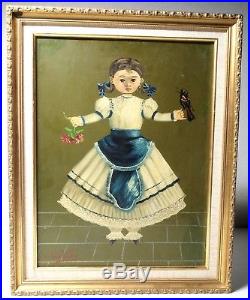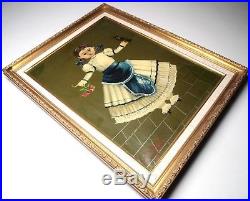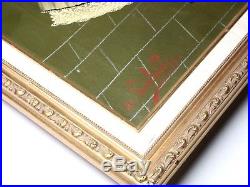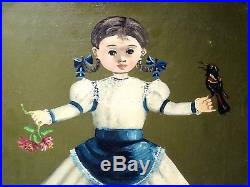
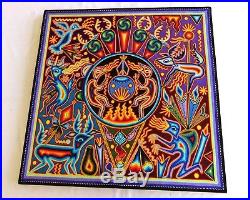
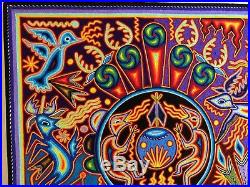
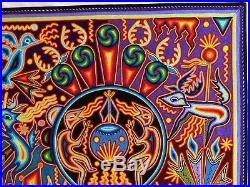
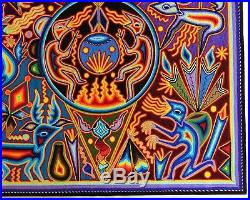
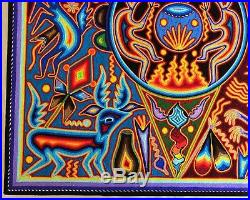

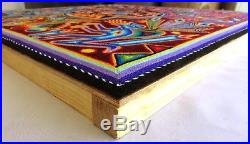

23.5 Mexican Huichol Yarn painting 60-102. Lenght 23.5 inches (59.69 cms). Width 23.5 inches (59.69 cms). Thick 1 inches (2.54 cms). This painting is entirely made with yarn applied with beeswax and resin over a sheet of plywood. There’s a description of the painting written by the artist in the back that reads. In this painting we can see a representation of the ritual that’s performed by the marakame for the peyote. The marakame and the pilgrims dance around the peyote so it can bless their offerings and crops. The eagle will carry the message of the shaman for the gods. The deer will guide the shaman during the ritual. In this painting you’ll see a representation of the peyote cactus or hikuri, the shaman or marakame, the muvieri, the gourd bowl, the rattles, the eye of God or Ojo de Dios, the deer or maxa, the snake and the eagle and the eagle or werika. The peyote cactus or “Hikuri”, is a plant that the huichol people keep as their most sacred good used it to open a spiritual connection with their gods. Peyote is the soul of their religious culture and a visionary sacrament that opens a pathway to the other deities. The word “mara’akame” means the one who knows, and is used to refer to the shaman in the huichol tribe. The marakames or shamans are the spiritual leaders. As ambassadors to the gods, shamans preside over ceremonies, recite the divine passages, cure the sick, interpret dreams, etc. He is the nexus with the gods, invoked through the ceremonial use of peyote, and receives instructions from the spirit world through visions, dreams and trances. The muvieri is a stick with feathers used by the marakame in their rituals. It’s a mean to contact their gods and receive their messages. It’s also used to heal, predict the future and in blessings. Sacred Gourds bowls are used by marakames or shamans as containers filled with important symbols, such as corn, animals, and images of family members. For the Huichol people, the Ojo de Dios or God’s eye is symbolic of the power of seeing and understanding that which is unknown and unknowable, The Mystery. The four points represent the elemental processes: earth, fire, air, and water. In a ceremonial meaning, the Ojo de Dios is an offering to the gods to ask for the well being of the children. The parents are in charge of making the eye of god that the children will bring to the “drum ritual”. In this ritual, the children are presented before the gods so they can initiate their life as members of the tribe. Each year they add a new line or rhombus to the eye of good, in the children’s day of birth. The Huichol believe the deer or Maxa represents the heart and is the gatekeeper and guide to the spirit world. The spirit guide Maxa, who leads the shamans on their visionary pathways and teaches them how to gain their special knowledge. The eagle represents the communication bridge between god and men. The snakes guide the shaman or marakame during their rituals and are protectors of the peyote cactus. The Huichol represent one of the few remaining indigenous cultures left in Mexico. They live in self-imposed isolation, having chosen long ago to make their home high in the mountains of the Sierra Madre Occidental, in Western Central Mexico. Huichol Art dates back millenia. During spiritual rituals the shaman (know as marakame) have visions which are then transcribed into carvings, yarn art, bead art, pottery etc. Each image has spiritual meaning. The huichol tribe uses many simbols as representations of their deities and other things they deem sacred in their culture. Most common ones are the peyote, the deer and the snake. ASK ME IF YOU’RE LOOKING FOR SOMETHING ELSE. The item “23.5 Huichol yarn painting, Mexican Folk art, Wall art, Mexican painting 60-102″ is in sale since Saturday, May 12, 2018. This item is in the category “Collectibles\Cultures & Ethnicities\Latin American\Mexico\Huichol Art”. The seller is “dking_e” and is located in Tepic, Nayarit. This item can be shipped worldwide.
- Country/Region of Manufacture: Mexico


